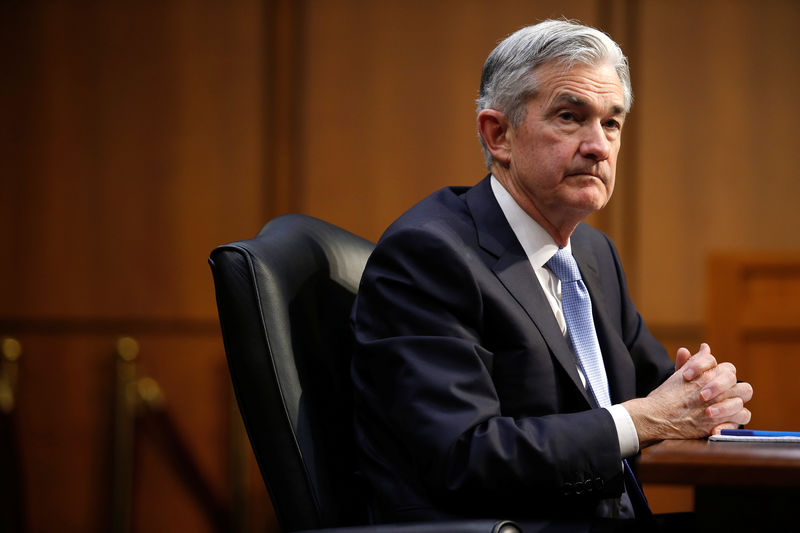Investing.com - Here are the top five things you need to know in financial markets on Thursday, February 22:
1. Global Stocks Slump Amid Fed-Driven Jitters
Global stocks were on the backfoot, after minutes of the Federal Reserve's January meeting underlined expectations for faster U.S. interest rate hikes, souring appetite for riskier assets around the world.
Asian markets ended broadly lower, with Hong Kong's Hang Seng and Japan's Nikkei 225 faring the worst, closing down around 1.5% and 1.1% respectively.
But Chinese markets were in a better mood, returning from their long holiday break with a gain of about 2.2% for the Shanghai blue-chip index.
In Europe, stocks were notably weaker in mid-morning trade. The Stoxx Europe 600 index, the region's broadest measure of share prices, fell 0.9%, with all sectors and major bourses in negative territory.
Meanwhile, early indications from U.S. futures suggest another day in the red for Wall Street. Dow futures were down nearly 100 points, or around 0.4%, while S&P 500 futures fell 5 points, or about 0.2%. Nasdaq 100 futures lost 30 points, or roughly 0.4%.
U.S. stocks ended a tumultuous session firmly lower on Wednesday, with the Dow erasing gains of nearly 300 points following the release of the hawkish Fed minutes.
2. Dollar, Treasury Yields Stand Tall Thanks To Hawkish Fed View
The U.S. dollar rose to a one-and-a-half-week high against a basket of major currencies, boosted by speculation the Fed will raise interest rates at a faster pace than currently expected.
The dollar index, which gauges the U.S. currency against a basket of six major rivals, reached its best level since Feb. 12 at 90.17 in overnight trade. It was last at 90.05, well above a three-year low of 88.15 touched last week.
Meanwhile, yields on the 10-year bond were last trading at 2.925%. They rose to a four-year peak of 2.957% a day earlier, creeping ever closer to 3% - a huge psychological milestone for bulls and bears alike.
There are a number of Fed speakers Thursday. Markets will especially be watching for comments from New York Fed President William Dudley, who will hold a 10AM ET (1500GMT) briefing about Puerto Rico and the Virgin Islands, but he could say something beyond that topic, especially after Wednesday's turbulent trading.
Atlanta Fed President Raphael Bostic speaks at 12:10PM (1710GMT) on the economic outlook, while Dallas Fed President Rob Kaplan speaks at 3:30PM (2030GMT) in Vancouver on trade.
On the data front, the highlight of Thursday's rather light economic calendar will be weekly jobless claims figures at 8:30AM ET (1330 GMT).
3. Oil Under Pressure Ahead of EIA Weekly Supply Report
The U.S. Energy Information Administration will release its weekly report on oil supplies, which comes out one day later than usual due to Monday's Presidents' Day holiday, at 11:00AM ET (1600GMT), amid analyst expectations for a gain of nearly 1.8 million barrels.
The American Petroleum Institute said late Wednesday that U.S. oil inventories fell by 0.9 million barrels last week. There are often sharp divergences between the API estimates and the official figures from EIA.
Oil prices were under pressure, with WTI crude futures dropping 1% to $61.11 per barrel, while Brent crude futures were at $64.91 per barrel, down 0.8%.
4. Bitcoin Slides Back Towards $10,000-Level
The prices of major cryptocurrencies continued lower for the second day in a row, with Bitcoin, Ethereum and Ripple all suffering significant declines, as overall market sentiment waned.
The price of the world's biggest virtual currency by market cap, Bitcoin lost around 4% to $10,521, after hitting an overnight low of $10,200. After nearly doubling in price since the Feb. 6 low close to $6,000, traders have begun dumping some of their holdings, market participants said.
The news was no better for other major digital currencies, with Ethereum, the world’s second largest cryptocurrency by market cap, falling around 5% to a one-week low of $842.20.
The third largest cryptocurrency Ripple slumped around 4% to trade at $0.96571. It has declined more than 60% so far this year, making it one of the worst performing digital currencies of 2018.
5. UK Economic Growth Revised Lower
Britain's economy grew more slowly than first thought during the three months to December, official figures showed, raising questions about the economy's strength as the Bank of England prepares to raise interest rates.
Gross domestic product grew by 0.4% between October and December, the Office for National Statistics said, below economists' forecasts and a preliminary estimate of 0.5%. In year on year terms, downwardly revised growth of 1.4% was the weakest in more than five years.
The pound lost ground against the dollar, with GBP/USD falling to a one-week low of 1.3880.
